Key takeaways:
- Educational games effectively blend learning with play, increasing engagement and fostering curiosity in students.
- Programming in education promotes critical thinking, creativity, and collaboration among learners.
- Game design principles, such as feedback and storytelling, enhance player engagement and can deepen their emotional connection to the content.
- Incorporating educational elements seamlessly into gameplay, such as rewards and challenges, significantly enhances the learning experience.
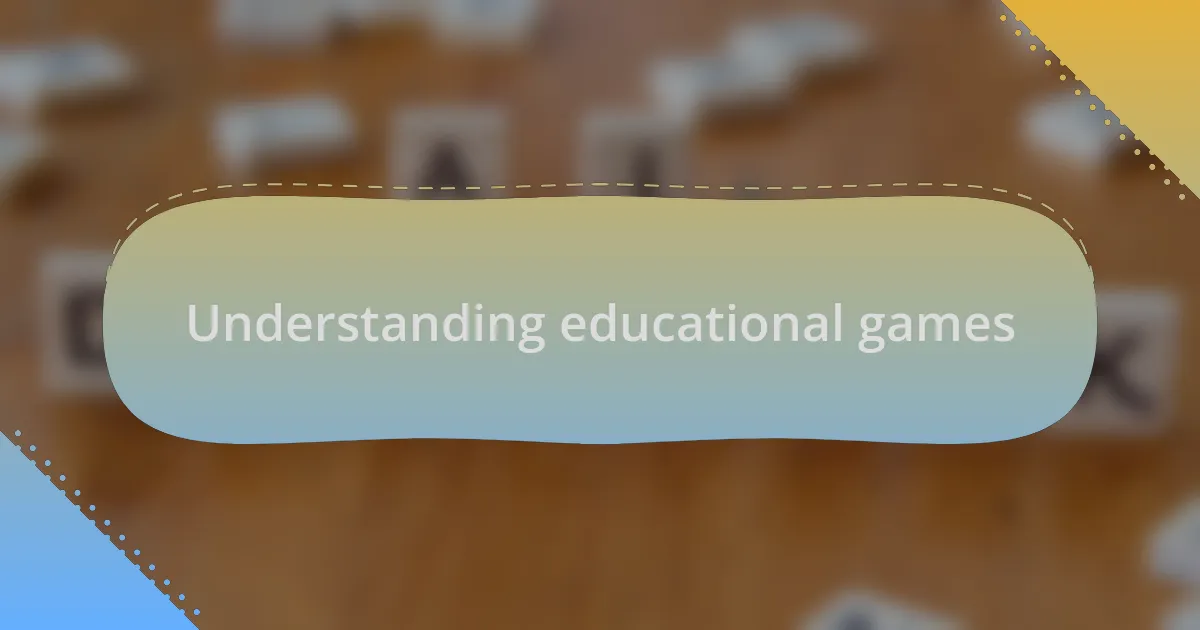
Understanding educational games
Educational games are fascinating because they blend learning with play, creating an environment where students can absorb information without feeling overwhelmed. I remember the first time I encountered a coding game aimed at kids; not only did it present programming concepts as fun challenges, but it also sparked my curiosity about technology. How many of us can say that a game changed our perspective on learning?
While playing these games, I often found that the interactive elements kept me engaged longer than traditional methods. There’s something uniquely rewarding about solving a puzzle or completing a quest that reinforces knowledge. I sometimes ask myself, “What made this experience so enjoyable?” The answer lies in the balance between challenge and fun, which is crucial in educational game design.
Moreover, educational games often incorporate real-world scenarios that make concepts easier to relate to. When I played a simulation game about environmental conservation, I felt an emotional connection to the cause, as it mirrored real issues our planet faces. This kind of engagement not only helps players grasp complex ideas but also fosters a sense of responsibility and empathy towards the world.
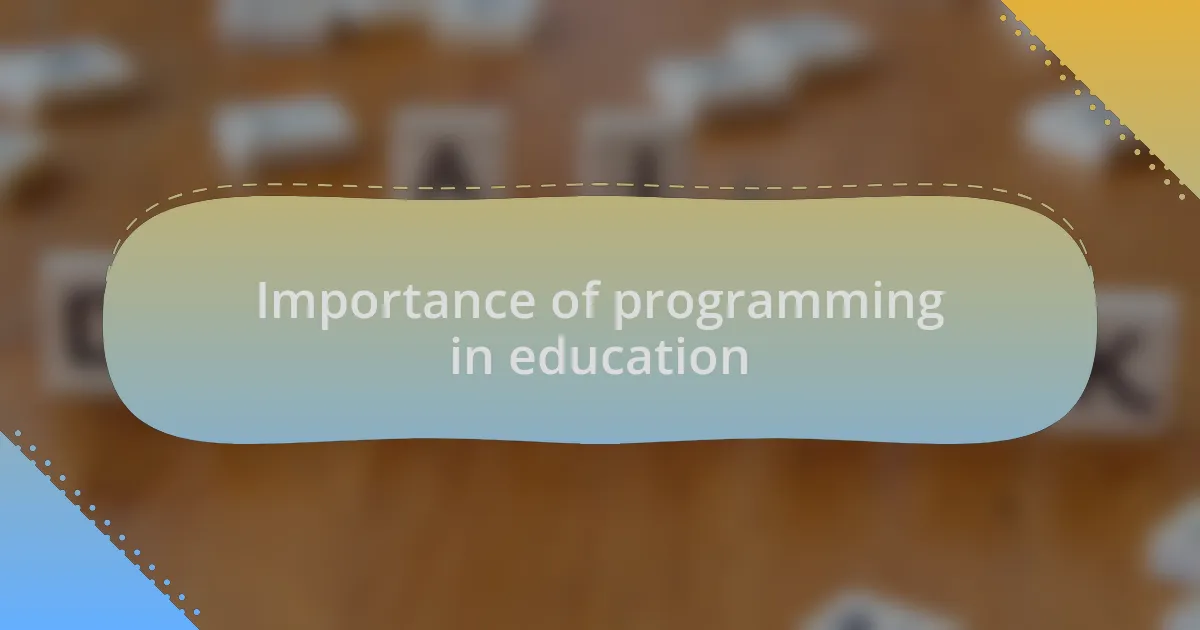
Importance of programming in education
Programming holds immense value in education, serving as a gateway to critical thinking and problem-solving skills. I recall my early experiences with coding, where each line of code felt like a puzzle waiting to be deciphered. Didn’t it feel amazing to realize that a single mistake could either hinder progress or lead to a breakthrough? That moment of understanding can truly transform a student’s approach to learning.
Incorporating programming into educational curricula encourages creativity and innovation. I often marvel at how students can turn their ideas into tangible projects through coding. It’s exhilarating to watch someone go from having a vague concept to creating an interactive app. How empowering is it to teach young minds that their imagination can translate into something real?
Additionally, programming fosters collaboration and communication skills among students. I remember working on a group project where we developed a simple game together. We divided tasks based on our strengths, which resulted in lively discussions and shared learning experiences. Isn’t it fascinating how coding can break down barriers, teaching us to work together towards a common goal while learning invaluable technical skills?

Basics of game design principles
Game design principles are the foundational components that shape engaging and interactive experiences. When I first started developing games, I quickly realized that understanding the core mechanics was crucial. For instance, the balance between challenge and skill can make or break a player’s experience. Have you ever played a game that was either too easy or too difficult? It often leaves you frustrated rather than entertained.
Another essential principle is the significance of feedback in games. I vividly remember a moment while testing a game I designed; players would either cheer or groan based on immediate responses to their actions. That instant gratification creates a connection, making the player feel invested in the outcome. In design, it’s vital to ensure that feedback is clear and rewarding; it fosters a sense of progress and achievement that keeps players coming back for more.
Furthermore, storytelling plays a pivotal role in engaging players. I once created a simple platformer but found that the moments I added a backstory made all the difference in how players engaged with the game. They weren’t just jumping from platform to platform; they were on a quest! Isn’t it fascinating how a narrative can deepen our emotional connection, turning a good game into a memorable adventure?
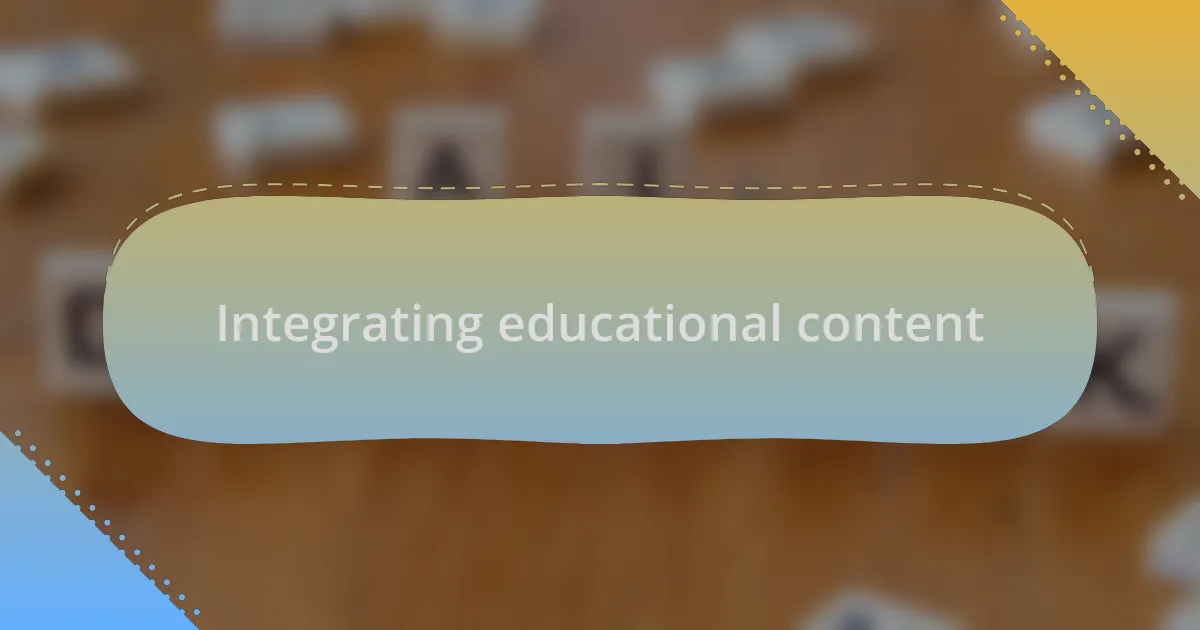
Integrating educational content
Integrating educational content into games can transform the way players learn while they play. I remember developing a game that incorporated math puzzles as part of the main objectives. Players were so engrossed in solving the puzzles that they didn’t realize they were sharpening their skills. It struck me how seamlessly education could blend with gameplay, creating an enriching experience without feeling overly instructional.
One technique I often use is embedding quizzes or challenges that align with the game’s storyline. For example, in a historical adventure game I designed, players had to answer questions related to the era to unlock new levels. This made the learning feel like a natural progression of their journey. Don’t you find that when education feels like a part of the play, it enhances engagement significantly?
Moreover, creating a reward system for players when they successfully complete educational tasks can reinforce learning. I implemented a point system in one of my games where players earned bonus points for correctly answering trivia questions about programming concepts. Seeing their excitement when they achieved a new high score made me realize how effective positive reinforcement can be in education. It not only motivates players but also helps them retain information better.
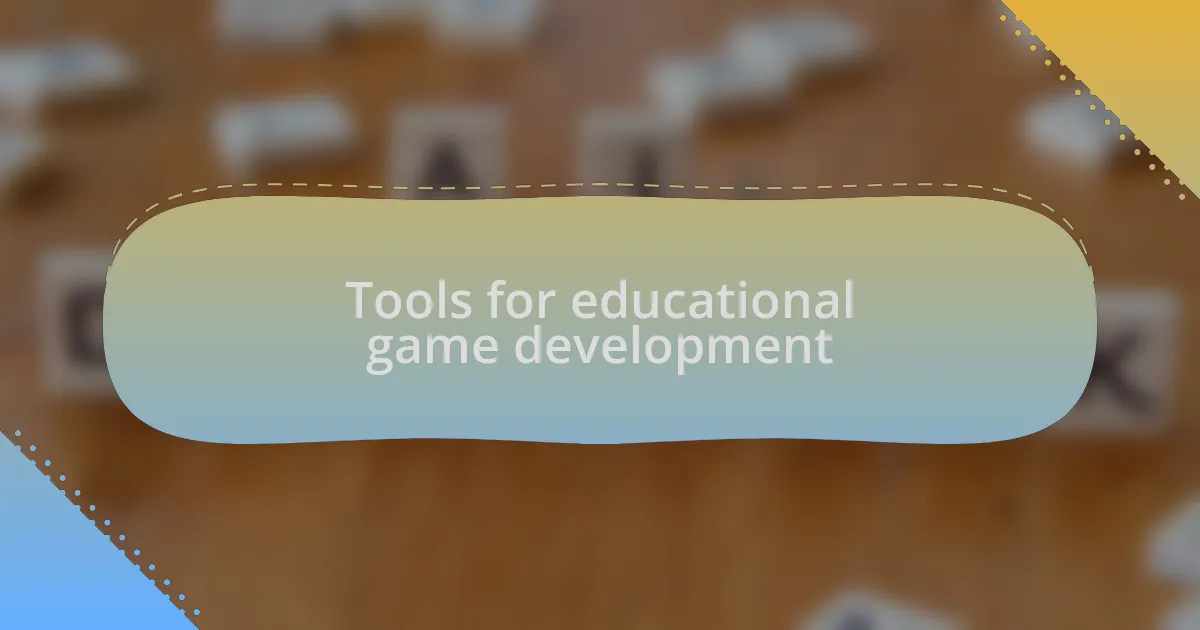
Tools for educational game development
When it comes to educational game development, choosing the right tools is crucial. One platform that I’ve found particularly helpful is Unity. Its flexibility allows for the creation of rich, interactive experiences. I remember when I was building a science-themed game; Unity’s asset store provided me with resources that saved time and enhanced the visual elements, making the educational aspects pop. Have you ever experienced that “aha” moment when the right tool elevates your project?
Another useful tool is Twine, which is perfect for creating branching narratives. I once crafted an interactive story that required players to make choices based on ethical dilemmas. Using Twine allowed me to visualize the pathways and ensure educational content was woven seamlessly into the story. The intuitive interface not only made the process enjoyable, but I also noticed players being more invested in the outcome. Don’t you think engaging narratives can spark curiosity and drive learning?
Lastly, incorporating game engines like Gamestar Mechanic can be immensely rewarding. This tool allows users to create their own games, effectively putting them in the developer’s shoes. I had a group of students use Gamestar Mechanic for a project, and it was beautiful to see them strategize and problem-solve while learning game design principles. Their enthusiasm reminded me that when learners become creators, it transforms their educational experience completely. How powerful is it to see players actively engage in the learning process?

Personal experiences with educational games
I have vivid memories of introducing my younger sibling to educational games. One summer, we played a math-based adventure game that turned solving equations into a thrilling quest. I could see the joy on her face when she discovered that solving problems meant unlocking new levels, which reminded me just how effective gamification is in making learning fun and engaging. Don’t you find it rewarding when education feels more like play?
Another personal experience that stands out is when I developed a language-learning game. I integrated vocabulary challenges with engaging story elements, and it was fascinating to watch my friends form a competitive spirit around it. The laughter and excitement that filled the room as they raced to outsmart each other highlighted the importance of social interaction in education. Isn’t it interesting how a competitive edge can enhance motivation in learning?
One of my most memorable experiences was using an educational game during a workshop I led. The game required participants to collaborate and solve real-world problems through gameplay. I clearly remember their initial hesitation, but as we engaged deeper into the game, their enthusiasm blossomed. That transition from skepticism to excitement reinforced my belief that well-designed educational games can be transformative, sparking curiosity and collaboration in ways traditional teaching sometimes fails to do. Have you ever seen that change in attitude when a learning experience suddenly resonates?
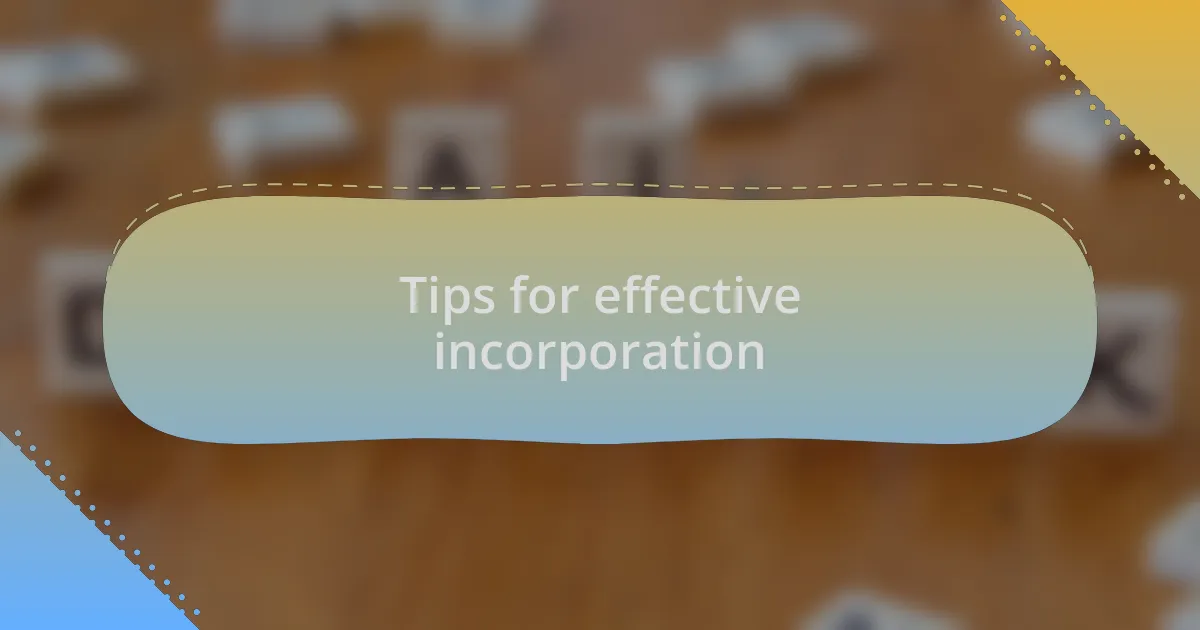
Tips for effective incorporation
When it comes to incorporating educational elements into games, I’ve found that clarity is key. It’s essential to ensure that the learning objectives are clearly articulated within the game mechanics. For instance, I once designed a coding game where players had to debug simple programs to advance. Clearly defining what skills they would gain not only motivated them but also helped them see the direct connection between gameplay and their learning progress.
Another effective tip is to blend challenges with rewards seamlessly. I remember creating a geography-based game that awarded players with virtual badges for correctly answering questions about different countries’ capitals. The thrill of receiving a badge was a game-changer for many—it turned mundane facts into a source of pride and excitement. Don’t you think that kind of recognition encourages players to push their boundaries further?
Finally, involving players in the design process can lead to more meaningful engagement. I once hosted a session where participants could suggest their own educational game ideas, and the creative energy was palpable. Witnessing the spark of creativity as they brainstormed ideas made me realize that when people feel a sense of ownership, they invest more in the learning experience. How do you think player involvement can change the way educational content is perceived?